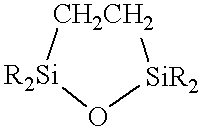Method for producing linear organopolysiloxanes with alpha, omega, terminal Si-linked alkenyl groups or alpha, omega terminal-linked hydrogen atoms
a technology of terminal links and hydrogen atoms, applied in the direction of liquid surface applicators, organic chemistry, coatings, etc., can solve the problems of inability to manufacture, complex and expensive preparation, and previously inability to manufactur
- Summary
- Abstract
- Description
- Claims
- Application Information
AI Technical Summary
Problems solved by technology
Method used
Image
Examples
example 2
642 g of an .alpha.,.omega.-divinyldimethylpolysiloxane having an iodine number of 41.6 are mixed with 285 g of an .alpha.,.omega.-dihydrogendimethylpolysiloxane having 0.35% by weight of Si-bonded hydrogen, and Karstedt catalyst is then added to the homogeneous siloxane mixture in an amount such that the total batch contains 5 ppm of platinum. After heating to 120.degree. C. for two hours, a linear polymer having --C.sub.2 H.sub.4 -- bridges and terminal vinyldimethylsiloxane units, in which no Si-bonded hydrogen is detectable and which has only 0.8% by weight of volatile components, is obtained. The linear polymer has a viscosity of 97,000 mPa.s at 25.degree. C. and an iodine number of 0.7.
example 3
175 g of a mixture of an .alpha.,.omega.-dihydrogenpolydimethylsiloxane having 0.058% of Si-bonded hydrogen and an .alpha.,.omega.-divinylpolydimethylsiloxane having a vinyl content of 0.92% in a mass ratio of 1:1.892, having a viscosity of 116 mm.sup.2 / s, are stirred with 5 to 30% of the total amount of water (300 g of demineralized water) and 25 g of emulsifier Arlypon IT 10 / 80 (from Grunau) (Arlypon IT 10 / 80 corresponds to the average formula C.sub.13 H.sub.27 O (C.sub.2 H.sub.4 O).sub.10 H) in a rotor-stator emulsifying apparatus (Turrax; from Janke & Kunkel) for 2 to 3 min. Thereafter, 1000 ppm of a 1% strength (based on Pt) solution of Karstedt catalyst in vinylsiloxane are incorporated for 1 to 2 min and this mixture is then diluted with the remaining water.
An emulsion having an average particle size of about 280 nm is obtained. By evaporating down the emulsion and reextracting the polysiloxane with n-heptane, a material having a high viscosity of 145,000 mpa.s and a vinyl c...
example 4
The mixture (175 g) from Example 3 is mixed with 1000 ppm of the same platinum catalyst in a laboratory dissolver (from Molteni) and homogenized for 1 min., after which 25 g of emulsifier IT 10 / 80 and 300 g of demineralized water are added stepwise while stirring.
PUM
| Property | Measurement | Unit |
|---|---|---|
| degree of polymerization | aaaaa | aaaaa |
| atmospheric pressure | aaaaa | aaaaa |
| temperature | aaaaa | aaaaa |
Abstract
Description
Claims
Application Information
 Login to View More
Login to View More - R&D Engineer
- R&D Manager
- IP Professional
- Industry Leading Data Capabilities
- Powerful AI technology
- Patent DNA Extraction
Browse by: Latest US Patents, China's latest patents, Technical Efficacy Thesaurus, Application Domain, Technology Topic, Popular Technical Reports.
© 2024 PatSnap. All rights reserved.Legal|Privacy policy|Modern Slavery Act Transparency Statement|Sitemap|About US| Contact US: help@patsnap.com








